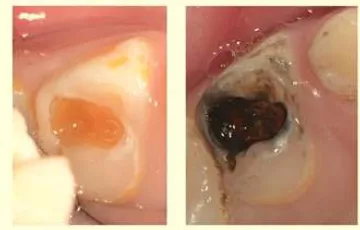Dentists have traditionally treated tooth decay with fillings here in the United States; but an alternative tooth decay management technique which has been used in other countries is gaining traction and becoming an alternative option for management of tooth decay in certain cases.
Silver Diamine Fluoride (SDF) is basically a ‘liquid antibiotic’ that can be applied in certain cases to cavities in the mouth. SDF has been shown to not only stop the progression of the cavity, but also to remineralize the decayed tooth surface and prevent further breakdown of the tooth.
What are the Advantages of SDF?
- Avoids traditional dental treatment (anesthetic, drilling and filling),
- Helpful and shown success in young children, the elderly, those with extensive decay, special needs populations and those with dental phobias,
- Minimally invasive and preserves tooth structure,
- Kills bacteria in the dentinal tubules,
- Helps reduce sensitivity,
- Lower cost than traditional dental treatment in certain situations,
- Safety profile of SDF is very good.
What are the Disadvantages of SDF?
- Darkening of the treated cavity. Does not typically stain or darken healthy tooth structure.
- The tooth may still require a conventional restoration to return it to full and normal function and esthetics.
- Requires multiple applications for predictable arrest of the cavity.
- Not indicated or effective if the cavity has already contaminated the nerve or pulp.
- Not indicated on patients with a history of silver allergy.
- May cause minor and short term stinging if contacting areas of the mouth with ulcerations, cuts or sores.
- Somewhat bitter taste, which is short-lived.
When is SDF a Viable Option?
It’s important to recognize that SDF merely ‘freezes’ or stops the decay process in a tooth (after several applications). It does not restore the hole caused by the cavity.
If the cavity is very deep and affecting the nerve or pulp of the tooth, conventional dental treatment (Filling, Root Canal / Pulpotomy or Extraction) is still the only effective way to manage the cavity and accompanying sensitivity or discomfort.
SDF does not restore full function and esthetics back to the tooth. It stops the cavity, but doesn’t fill the hole left by the cavity. A regular filling may still be needed, if full function and esthetics is needed.
SDF might be a good option when:
- A very young child has rampant decay, and would require sedation in a hospital to restore all their cavities. Sometimes, ‘freezing’ the decay process until that child is older and possibly able to tolerate their appointment, saves that child from full sedation and hospital dentistry.
- Patients who do not have regular access to a Dentist for care. Sometimes ‘freezing’ the decay process, helps preserve further breakdown of their teeth, until they can find and seek appropriate care.
- Elderly patients in Assisted Living facilities who may not be able to get to a Dental Office easily. SDF can help maintain their teeth longer.
- Mentally or physically handicapped patients who are not able to cooperate or withstand routine dental treatment and care.
- Patients whose Dental Phobias have prevented them from seeking conventional treatment would also benefit from stabilization of their decayed teeth, rather than further breakdown or possible loss of teeth.
- Patients who lack the finances to treat all their carious lesions and need to ‘buy some time’, until they can definitively restore and address their situation.
- Difficult to reach or access cavities where a tooth might be deemed ‘non-restorable’ and indicated for extraction.
- Patients who are accepting of the darkened lesion or area on the tooth treated with the SDF.
It is important to note that we will often times apply a tooth colored filling material over the top of the darkened tooth surface, but that filling may not mask the treated darkened area in its entirety and a dark halo or rim may still be present around the sides of the filling.
*The above picture show a tooth with an active cavity on the left and the same tooth on the right after a few treatments of SDF. The treated cavity is darkened, but the cavity is not advancing or getting bigger/deeper. The hole left by the cavity can be filled in with a tooth colored filling material to improve the function and esthetics of the tooth. The biggest advantage of SDF is stopping the progression and spread of the cavity.


